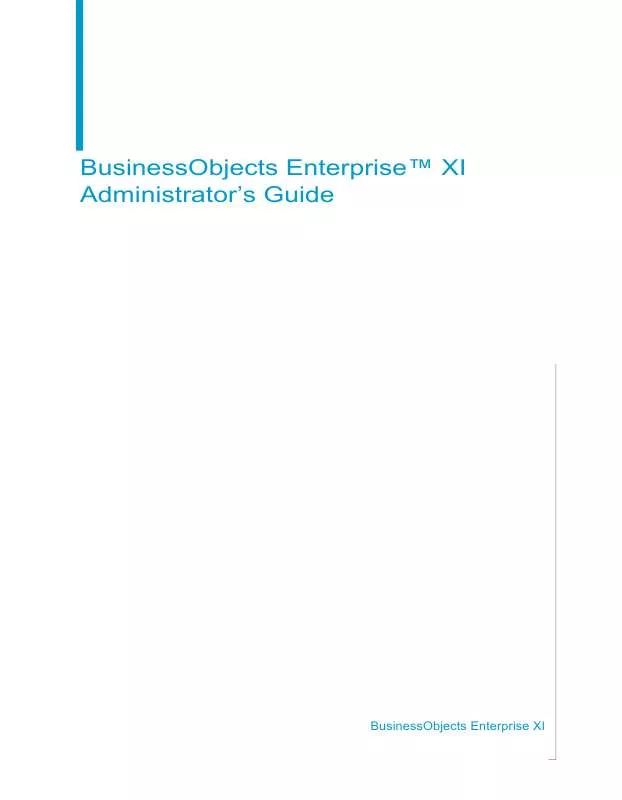User manual BUSINESS OBJECTS ENTERPRISE XI ADMINISTRATORS GUIDE
Lastmanuals offers a socially driven service of sharing, storing and searching manuals related to use of hardware and software : user guide, owner's manual, quick start guide, technical datasheets... DON'T FORGET : ALWAYS READ THE USER GUIDE BEFORE BUYING !!!
If this document matches the user guide, instructions manual or user manual, feature sets, schematics you are looking for, download it now. Lastmanuals provides you a fast and easy access to the user manual BUSINESS OBJECTS ENTERPRISE XI. We hope that this BUSINESS OBJECTS ENTERPRISE XI user guide will be useful to you.
Lastmanuals help download the user guide BUSINESS OBJECTS ENTERPRISE XI.


You may also download the following manuals related to this product:
 BUSINESS OBJECTS ENTERPRISE XI INFOVIEW (993 ko)
BUSINESS OBJECTS ENTERPRISE XI INFOVIEW (993 ko)
 BUSINESS OBJECTS ENTERPRISE XI RELEASE 2 (358 ko)
BUSINESS OBJECTS ENTERPRISE XI RELEASE 2 (358 ko)
 BUSINESS OBJECTS ENTERPRISE XI LIVE OFFICE (1066 ko)
BUSINESS OBJECTS ENTERPRISE XI LIVE OFFICE (1066 ko)
 BUSINESS OBJECTS ENTERPRISE XI RELEASE 2 INFOVIEW (1213 ko)
BUSINESS OBJECTS ENTERPRISE XI RELEASE 2 INFOVIEW (1213 ko)
 BUSINESS OBJECTS ENTERPRISE XI INSTALLATION GUIDE (1264 ko)
BUSINESS OBJECTS ENTERPRISE XI INSTALLATION GUIDE (1264 ko)
 BUSINESS OBJECTS ENTERPRISE XI GETTING STARTED GUIDE (778 ko)
BUSINESS OBJECTS ENTERPRISE XI GETTING STARTED GUIDE (778 ko)
 BUSINESS OBJECTS ENTERPRISE XI PORTAL INTEGRATION KIT (292 ko)
BUSINESS OBJECTS ENTERPRISE XI PORTAL INTEGRATION KIT (292 ko)
 BUSINESS OBJECTS ENTERPRISE XI RELEASE 2 FOR LINUX-AIX (285 ko)
BUSINESS OBJECTS ENTERPRISE XI RELEASE 2 FOR LINUX-AIX (285 ko)
 BUSINESS OBJECTS ENTERPRISE XI RELEASE 2.0 AUDITOR GUIDE (420 ko)
BUSINESS OBJECTS ENTERPRISE XI RELEASE 2.0 AUDITOR GUIDE (420 ko)
 BUSINESS OBJECTS ENTERPRISE XI RELEASE 2 PUBLISHING GUIDE (447 ko)
BUSINESS OBJECTS ENTERPRISE XI RELEASE 2 PUBLISHING GUIDE (447 ko)
 BUSINESS OBJECTS ENTERPRISE XI RELEASE 2 FOR SOLARIS-WINDOWS (832 ko)
BUSINESS OBJECTS ENTERPRISE XI RELEASE 2 FOR SOLARIS-WINDOWS (832 ko)
 BUSINESS OBJECTS ENTERPRISE XI RELEASE 2 ADMINISTRATOR GUIDE (2176 ko)
BUSINESS OBJECTS ENTERPRISE XI RELEASE 2 ADMINISTRATOR GUIDE (2176 ko)
 BUSINESS OBJECTS ENTERPRISE XI R2 PORTAL INTEGRATION KIT FOR PORTLETS (299 ko)
BUSINESS OBJECTS ENTERPRISE XI R2 PORTAL INTEGRATION KIT FOR PORTLETS (299 ko)
 BUSINESS OBJECTS ENTERPRISE XI RELEASE 2 ADMINISTRATOR REFERENCE GUIDE (922 ko)
BUSINESS OBJECTS ENTERPRISE XI RELEASE 2 ADMINISTRATOR REFERENCE GUIDE (922 ko)
 BUSINESS OBJECTS ENTERPRISE XI PORTAL INTEGRATION KIT ADMINISTRATOR GUIDE (232 ko)
BUSINESS OBJECTS ENTERPRISE XI PORTAL INTEGRATION KIT ADMINISTRATOR GUIDE (232 ko)
 BUSINESS OBJECTS ENTERPRISE XI RELEASE 2 DEPLOYMENT AND CONFIGURATION GUIDE (3161 ko)
BUSINESS OBJECTS ENTERPRISE XI RELEASE 2 DEPLOYMENT AND CONFIGURATION GUIDE (3161 ko)
 BUSINESS OBJECTS ENTERPRISE XI FOR UNIX RELEASE 2 IBM EDITION INSTALLATION GUIDE (1736 ko)
BUSINESS OBJECTS ENTERPRISE XI FOR UNIX RELEASE 2 IBM EDITION INSTALLATION GUIDE (1736 ko)
 BUSINESS OBJECTS ENTERPRISE XI PORTAL INTEGRATION KIT INSTALLATION GUIDE ORACLEAS 10G (195 ko)
BUSINESS OBJECTS ENTERPRISE XI PORTAL INTEGRATION KIT INSTALLATION GUIDE ORACLEAS 10G (195 ko)
 BUSINESS OBJECTS ENTERPRISE XI RELEASE 2 SET ANALYSIS ONLINE HELP FOR WINDOWS AND UNIX (829 ko)
BUSINESS OBJECTS ENTERPRISE XI RELEASE 2 SET ANALYSIS ONLINE HELP FOR WINDOWS AND UNIX (829 ko)
 BUSINESS OBJECTS ENTERPRISE XI R2 PORTAL INTEGRATION KIT ADMINISTRATOR GUIDE FOR PORTLETS (240 ko)
BUSINESS OBJECTS ENTERPRISE XI R2 PORTAL INTEGRATION KIT ADMINISTRATOR GUIDE FOR PORTLETS (240 ko)
 BUSINESS OBJECTS ENTERPRISE XI RELEASE 2 PRODUCTIVITY PACK INSTALLATION GUIDE FOR WINDOWS (1948 ko)
BUSINESS OBJECTS ENTERPRISE XI RELEASE 2 PRODUCTIVITY PACK INSTALLATION GUIDE FOR WINDOWS (1948 ko)
 BUSINESS OBJECTS ENTERPRISE XI R2 PORTAL INTEGRATION KIT FOR MICROSOFT SHAREPOINT WEB PARTS (595 ko)
BUSINESS OBJECTS ENTERPRISE XI R2 PORTAL INTEGRATION KIT FOR MICROSOFT SHAREPOINT WEB PARTS (595 ko)
 BUSINESS OBJECTS ENTERPRISE XI RELEASE 2 CRITICAL HOT FIX INSTALLATION AND DEPLOYMENT GUIDE (60 ko)
BUSINESS OBJECTS ENTERPRISE XI RELEASE 2 CRITICAL HOT FIX INSTALLATION AND DEPLOYMENT GUIDE (60 ko)
 BUSINESS OBJECTS ENTERPRISE XI RELEASE 2 DASHBOARD MANAGER ONLINE HELP FOR WINDOWS AND UNIX (9312 ko)
BUSINESS OBJECTS ENTERPRISE XI RELEASE 2 DASHBOARD MANAGER ONLINE HELP FOR WINDOWS AND UNIX (9312 ko)
 BUSINESS OBJECTS ENTERPRISE XI R2 PORTAL INTEGRATION KIT INSTALLATION GUIDE FOR BEA WEBLOGIC (192 ko)
BUSINESS OBJECTS ENTERPRISE XI R2 PORTAL INTEGRATION KIT INSTALLATION GUIDE FOR BEA WEBLOGIC (192 ko)
 BUSINESS OBJECTS ENTERPRISE XI R2 PORTAL INTEGRATION KIT INSTALLATION GUIDE FOR ORACLEAS 10G (196 ko)
BUSINESS OBJECTS ENTERPRISE XI R2 PORTAL INTEGRATION KIT INSTALLATION GUIDE FOR ORACLEAS 10G (196 ko)
 BUSINESS OBJECTS ENTERPRISE XI R2 PORTAL INTEGRATION KIT INSTALLATION GUIDE FOR IBM WEBSPHERE (193 ko)
BUSINESS OBJECTS ENTERPRISE XI R2 PORTAL INTEGRATION KIT INSTALLATION GUIDE FOR IBM WEBSPHERE (193 ko)
 BUSINESS OBJECTS ENTERPRISE XI RELEASE 2 PERFORMANCE MANAGER ONLINE HELP FOR WINDOWS AND UNIX (2769 ko)
BUSINESS OBJECTS ENTERPRISE XI RELEASE 2 PERFORMANCE MANAGER ONLINE HELP FOR WINDOWS AND UNIX (2769 ko)
 BUSINESS OBJECTS ENTERPRISE XI RELEASE 2 PREDICTIVE ANALYSIS ONLINE HELP FOR WINDOWS AND UNIX (2652 ko)
BUSINESS OBJECTS ENTERPRISE XI RELEASE 2 PREDICTIVE ANALYSIS ONLINE HELP FOR WINDOWS AND UNIX (2652 ko)
 BUSINESS OBJECTS ENTERPRISE XI PORTAL INTEGRATION KIT INSTALLATION GUIDE MICROSOFT SHAREPOINT (309 ko)
BUSINESS OBJECTS ENTERPRISE XI PORTAL INTEGRATION KIT INSTALLATION GUIDE MICROSOFT SHAREPOINT (309 ko)
Detailed instructions for use are in the User's Guide.
DISCLAIMER TO DOWNLOAD THE USER GUIDE BUSINESS OBJECTS ENTERPRISE XI
Lastmanuals offers a socially driven service of sharing, storing and searching manuals related to use of hardware and software : user guide, owner's manual, quick start guide, technical datasheets...
In any way can't Lastmanuals be held responsible if the document you are looking for is not available, incomplete, in a different language than yours, or if the model or language do not match the description. Lastmanuals, for instance, does not offer a translation service.
Click on "Download the user manual" at the end of this Contract if you accept its terms, the downloading of the manual BUSINESS OBJECTS ENTERPRISE XI will begin.
